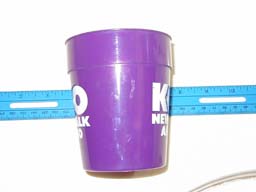
When I took the pictures of the TubaFest, I noticed that the band's purple T-shirts came out blue.
I decided to do some further experimenting at home. All the pictures have been resized in Photoshop and saved with "medium" compression, but have not had their color balance or levels adjusted. The cup is purple in real life.The first two pictures were taken in flourescent light. The first picture has no special settings; the second picture has EV set to +1.0, and it more accurately represents the cup's color.


Just for contrast, and again, using the same fluorescent light, let's add a blue ruler to the picture. Again, the first picture has no special settings; the second picture has EV set to +1.0


This calls the question: is fluorescent light a factor? To test this, I took the cup and ruler outside.
Before I took the pictures which you see below, I focused directly on the cup and the camera said it needed flash! Either the camera is incredibly sensitive to light levels or the shadows cast by the cup fooled the meter averaging. (I did not test with spot metering.) I then focused on the white table; the camera said it didn't need a flash, then I re-centered on the cup while holding the shutter button in the halfway position.
Again, the first picture has no special settings; the second picture has EV set to +1.0


Just to make things interesting, I tried photographing the cup along with a red-white-and-blue jacket, a yellow ice cream scoop, and a green watering can. These are both set to EV 0.0, no flash. The third picture uses the flash to eliminate shadows. Again, notice how the purple cup reacts. (It's up and to the right of the ice cream scoop in the last two pictures)



See also this page from a gentleman in Finland who has done a more scientific evaluation of this sort of problem.